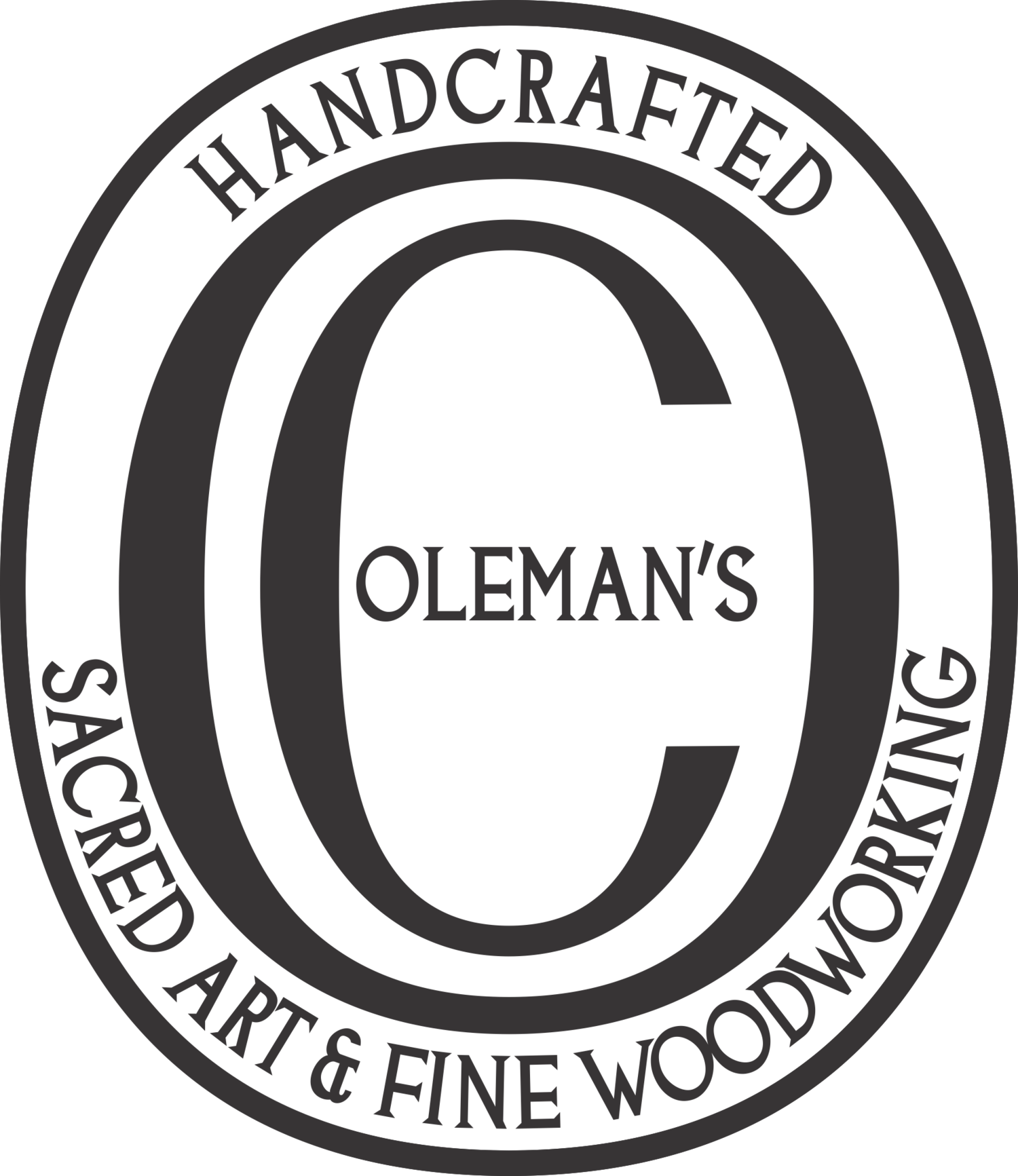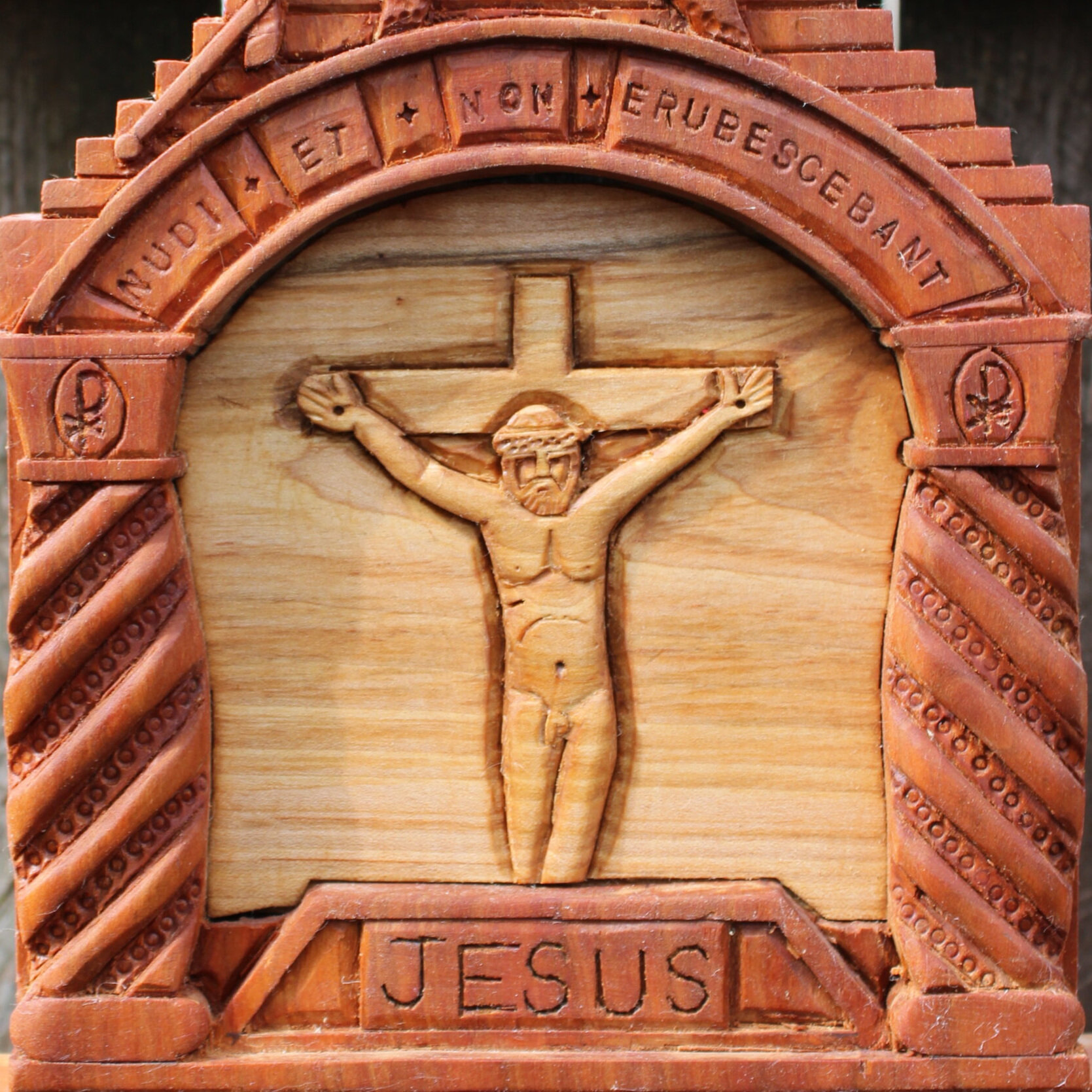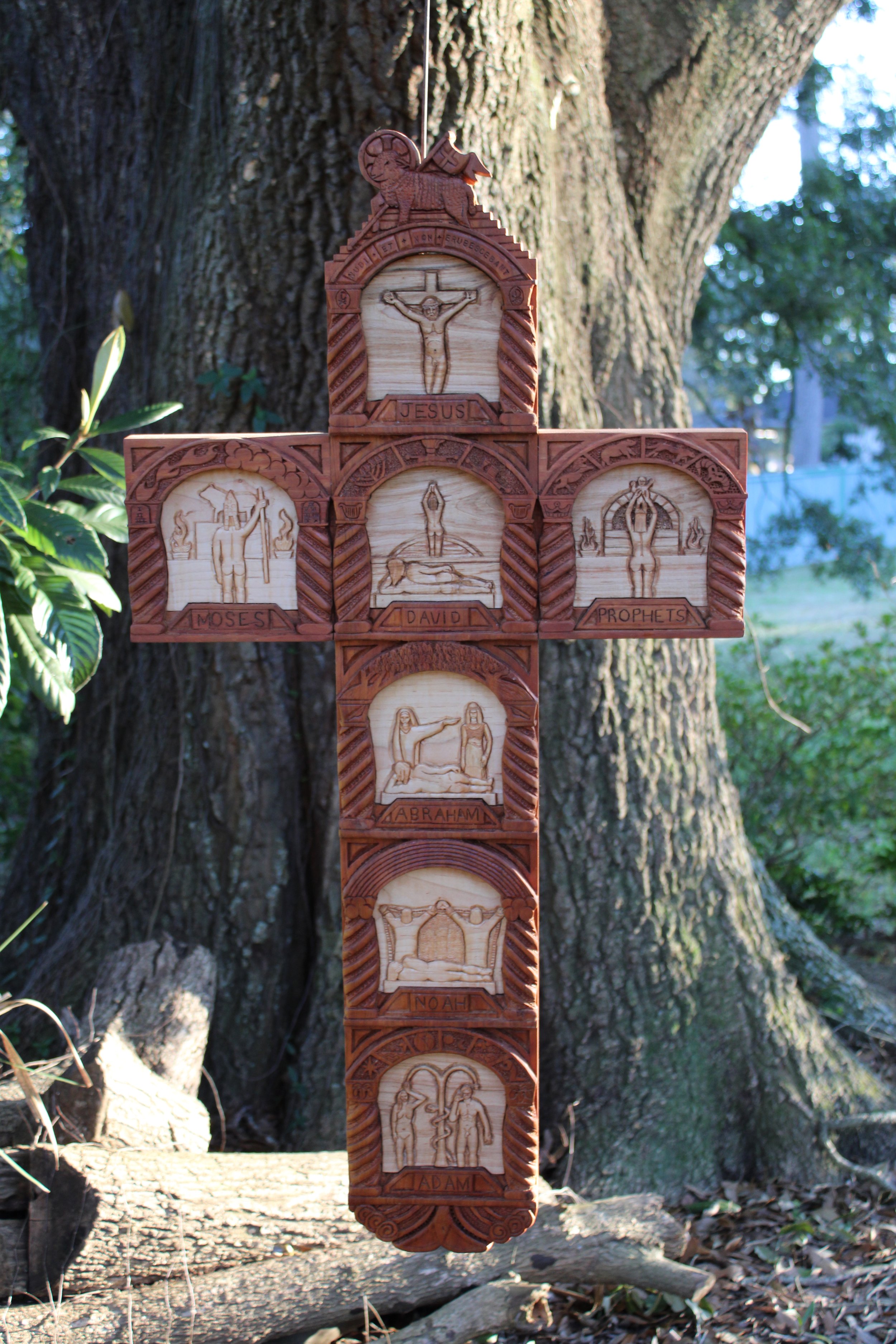
Christ and the Redemption of the Flesh
September 2019
This carving displays one of the more obscure and difficult themes in Salvation History: the relationship between naked bodily shame and the “falls” in the seven major covenants of the Bible. The intention behind such an image is to help reveal a theme that God Himself has used in the story of our salvation - taking our sinfulness and mysteriously orienting it for His greater glory - in as tasteful a way as possible.
The cross is composed of seven maple carvings each depicting the primary sin or “fall” of each covenant. Each maple carving is inset in a cherry frame that displays symbols relevant to God’s action in each covenant.
The endcap of the cross, below the image of Adam and Eve, is the flukes of a whale in the midst of raging waters. The original word that is used for “serpent” in the Hebraic text is similar to the word for “sea-monster”, thus the whale has assumed a sinister connotation in symbology. The chaotic waters of Genesis symbolize the formless void which God brought to order and resolution through the act of creation. The placement of this endcap below Adam and Eve calls to mind the fall of the devil and his angels before the covenant between God and man.
The Adam and Eve panel is based upon common motifs found historically in both art and theology. Eve casually takes the fruit and listens to the serpent, usurping the headship of her husband Adam, whilst he fails in his manly duty and raises his hand in fear. The fig leaves on the capitals of the columns refer to Genesis 3:7 when Adam and Eve “sewed fig-leaves together, and made themselves girdles.” It is also speculated that the fig may have been the fruit of the forbidden tree, since the fig is the only type of tree named in the story. If this were so, this signifies that Adam and Eve clothed themselves with their sin. The arch of the cherry frame depicts the first six days of creation.
The Noah panel exhibits the fall described in Genesis 9:18-29. Noah, “drinking of the wine was made drunk, and was uncovered in his tent” (v. 21). Ham looks upon his father’s nakedness, but Noah’s other two sons, with their faces averted, cover him. It is thus implied that Ham is guilty of great irreverence, and possibly of subverting Noah’s role as head. In the following verses, Noah curses Canaan, the son of Ham. The capitals of the frame depict the clouds supporting the rainbow arch, but they are also intended to represent the rain clouds of the Flood.
The Abraham panel displays the third major covenant in Salvation History and its subsequent fall. After decades of waiting for God to fulfill His promise and provide children for him, Abraham listens to his wife in defiance of God’s will and sleeps with the Egyptian Hagar. Hagar bears a son, Ishmael, who “shall be a wild man: his hand will be against all men, and all men’s hands against him” (Gen 16:12). The image of the flint knife on either capital symbolizes both the Lord’s command that all the Israelites be circumcised (Gen 17:10-14) and the binding of Isaac (Gen 22:1-18). The arch bears an image of the terebinth tree where three angels reveal to Abraham that he will finally have a son (Gen 18:1-5).
The Moses panel is the worship of the golden calf as told in Exodus 32:1-5, and the pagan worship ceremony has very strong sexual references. The man in the panel is Aaron, hence the miter and staff symbolizing his priesthood, for Aaron was the one leading the pagan worship, as Moses was on Mount Sinai with the Lord. It is worth noting that had Abraham followed God’s original plan described at the burning bush (Exodus 3:1-22, Exodus 4:1-20), Aaron would not have held such a place of authority. The capitals show the tablets of the Ten Commandments, and the arch displays the means by which God led His people through the wilderness: the Glory Cloud by day and the Pillar of Fire by night.
The David panel is the well-known story found in 2 Samuel of David’s lust for Bathsheba, who was already married to Uriah, and of David’s distraction from his duty to lead the armies, who were fighting the enemies of God. The harpsichord on the capitals refer to David’s role in creating most of the Psalter. The Davidic covenant also led to Solomon’s creation of the Temple, which housed the Bread of the Presence, the Menorah, and the Altar of Incense in the Holy Place, the sacred room adjacent to the Holy of Holies where God dwelt. These three items reflect highly Trinitarian symbolism and are carved into the arch of the panel.
The prophets panel represents a theme throughout all prophetic literature: Although God espoused Himself to the people of Israel through covenant relationships, the Israeltes were adulterous toward Him and constantly worshipped pagan gods. The maple panel draws on Ezekiel 16, when the Lord says: “I spread my garment over thee, and covered thy ignominy. And I swore to thee, and I entered into a covenant with thee, saith the Lord God: and thou becamest mine” (v. 8). But later in the chapter: “But trusting in thy beauty, thou playst the harlot because of thy renown, and thou hast prostituted thyself to every passenger… and thou hast taken thy sons, and thy daughters, whom thou hast borne to me: and best sacrificed the same to them to be devoured” (v. 15, 20). The arch and capitals are taken from a vision in Daniel 7, wherein four beasts - a lioness, a bear, a leopard, and a “terrible” fourth beast - are interpreted to be the four kingdoms that will rule over Israel before the coming of the Messiah. The two crowns on the capitals refer to the Ancient of days and the Son of man sitting co-equal in power as a foreshadowing of Jesus, the Son of God, being revealed as the Messiah.
The seventh and everlasting covenant between Jesus and His Bride, the Church, is made manifest with Him naked on the cross. The crucifixion of Jesus was the most wicked sin ever committed, and yet the greatest of goods has been achieved - the salvation of the human race. The nakedness of Jesus is a total reversal and redemption of the sins of all the seven major covenants. Jesus commits no sin and yet fulfills all the types of Him that came before. It is through the union of crucified Christ and His Church that both body and soul may be made shameless and unperishing. The capitals display the Chi Rho, the Greek symbol for the Christ, and the arch bears the Latin inscription “Nudi et non erubescebant”, which means “Naked and not ashamed”, recalling the fall of Adam and Eve and how Christ on the cross restores dignity to our flesh.
The cross is topped with the victorious Lamb from Revelation, signifying the fulfillment of all Salvation History, including what is yet to come, and the end of the timeline. Behind the Lamb is a twelve-leveled pyramid, representing the New Jerusalem, the Bride of the Lamb (Revelation 21:14).
“Christ and the Redemption of the Flesh” measures 40” x 21” and is finished with boiled linseed oil. It is available for purchase.










